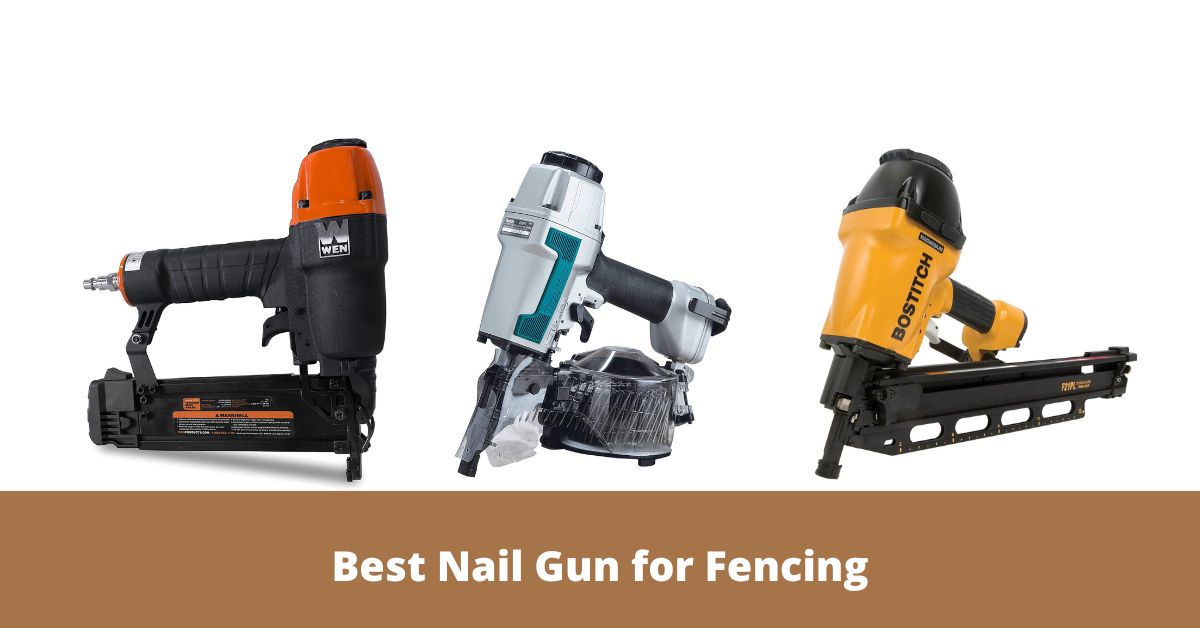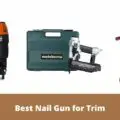Nail Gun
Best Nail Gun for Fencing
Best Nail Gun for Fencing
Time and again, nail guns have proven vital for the modern woodworker. Before they were a thing, hammers were pretty much the only way to drive nails and other fasteners into the wood.
Anyone can learn how to use a hammer, but they cause way more fatigue. They also necessitate holding down nails with your fingers, which makes it easier to injure yourself.
Nail guns are safer and work much faster. They’re my go-to for labor-intensive tasks such as fencing with 2x4 framing lumber.
What Size of Nails do you Need for Fencing?
Professional builders use 16d nails when working with framing lumber. 16 penny nails, as they’re sometimes known, measure 3 ½ inches, making them the perfect length for fastening thick lumber.
I’ve mostly encountered two types of 16d nails: common and sinker. Sinker nails tend to be thinner than common nails. They possess a flatter head that can be driven flush. Incidentally, that makes them great for counter sinking.
Sinker nails are often coated and much easier to hide than common nails.
How Much Power Should a Nail Gun Have?
Most nail guns are powered by air compressors, so I’ve grown to pay attention to them most. The two most important factors are the size of the compressor and the flow rate, which is measured in Cubic Feet per Minute (CFM) rating.
Frame nailing requires a higher flow rate than finish nailing, for instance. In a nutshell, I’ve found that a 6-gallon air compressor is enough for most nail guns, which tend to run on 0.5 to CFM at 90 PSI.
Most professionals will tell you that the size is not nearly as important as the CFM, which largely determines the punching power of your nail gun. Compressor size simply indicates its capacity for pressurized air.
What Types of Nail Guns Are There?
There are three types of nail guns you can use for framing:
Pneumatic
Fuel-powered
Cordless
Pneumatic nail guns run on compressed air and are the most widely available. They are considered the best tool for the job in many situations since they’re reliable, fairly easy to use, and can run infinitely, provided you have enough air compressors.
Worth noting is that pneumatic nail guns pack significantly more force than corded and fuel-powered models. They’re also capable of rapid firing, which makes them capable of working much faster.
Fuel-powered
These nail guns are slowly getting phased out by the arrival of cordless models. They run on a combination of battery power and fuel cell power. The battery is rechargeable, and the cells have a pretty long lifespan, so they don’t need to be replaced often.
Even though these nail guns are lighter and easier to handle, the cost of replacing fuel cells makes them fairly expensive to run.
Cordless
Cordless nail guns run solely on battery power. As expected, the battery makes them heavier and limits their runtime. But then, they’re a great convenience to have when you can’t access a power outlet when performing the odd roof maintenance project.
You should also note that these aren’t the most affordable nail guns available. It’s also quite expensive to replace their batteries, but you usually don’t have to worry about that.
How Important is Framing Angle?
The framing angle of a nail gun refers to the angle of its magazine in relation to the head. Most magazines are angled away from the head — the reason for that is to improve maneuverability, especially in tight spaces.
Most framing nailers you’ll encounter have magazines at 15, 21, 28, 30, and 34 degrees, and it’s important to match each type with the appropriate nail.
If you need it to fit into tight spaces, look towards the models in the 30 – 34-degree range. Nailers between 14 – 21 degrees use nails with full-round heads. 28-degree nailers can use full or clipped nails, but anything above 30 degrees exclusively uses clipped nails.
Framing Nail Guns to Buy for Fencing
WEN 61721 Pneumatic Brad Nailer
This 18-gauge nailer can shoot nails from 3/8 to 2 inches long. It’s powered by a quick-connect air compressor with a quarter-inch NPT air inlet and comes equipped with a 106-nail magazine.
In terms of power, it has plenty to drive 18-gauge brads into thick framing lumber. The depth adjustment wheel and nail gauge make it that much easier to select the right parameters for the job.
Its nose latch is a personal favorite. It’s designed to make clearing jams a quick and easy process.
Makita AN611 Coil Nailer
Coil nailers are high-capacity fasteners that I’ve found useful time and again. This Makita fires brads up to 2 ½ inches long with an air delivery system of 3.6 SCFM at 90 PSI with whisper-quiet precision.
It’s a great nailer for 15-degree collated wire and plastic nails and installing shingle siding and wood fiber cement. Tool-less depth adjustment makes it a joy to manipulate on the go. The canister has a viewing window and size adjustment, so it’s pretty easy to know when to reload.
It comes with a comfortable rubber grip, making it easy to use for long periods. There’s also a 3-year warranty attached to it.
BOSTITCH F21PL Pneumatic Nailer
This framing nailer comes with two quick-change nosepieces, allowing you to go from framing to metal connector jobs. It also has a unique depth adjustment setting; a button instead of a wheel that adjusts the depth incrementally.
The magnesium-built nailer is lightweight but very durable. It’s even built with an adjustable rafter hook for easy storage.
It delivers up to 1,050 pounds of the driving force. The trigger is quite versatile. It can be used as a sequential trigger or bump trigger to drive framing nails of up to 3 ½ inches as well as 1 ½ inch collated plastic wire and 2 ½ inch metal connectors.
The only downside is it weighs an uncomfortable 8.1 pounds, which does a number on the wrist after a while.
It’s slightly more expensive than I would prefer as a beginner, but the perks are evident. In fact, it even comes with a 7-year warranty.
Why You Should Trust Us
At Woodworking Tool Guide, we know one size doesn't fit all! We cater to every woodworker, from beginner to pro, with insights and recommendations tailored to your skill level, project needs, and budget. We take the guesswork out of choosing the right tools, whether you're tackling your first crafting a masterpiece for the ages. So grab your chisel, join our community, and let's build something amazing together!
Woodworking Tool Guide wasn't just born, it sprouted from a seed of passion for the craft. What started as a joyful exploration blossomed into a trusted online haven for fellow enthusiasts like you. We pour our love into meticulously chosen review selections, meticulous hands-on testing, and lab-backed insights, all to empower you with reliable, comprehensive information you can build on. So, grab your tools, trust our guidance, and let's build something beautiful together!
Passion-Driven Expertise
Our journey started with a shared love for woodworking. The team behind the Woodworking Tool Guide is comprised of individuals who are not just writers but passionate woodworkers themselves. This shared enthusiasm ensures that our content is crafted with a deep understanding of the craft and an authentic appreciation for quality tools.
Top Tool Guides Online
Woodworking Tool Guide has rapidly ascended to become one of the premier online destinations for tool guidance. Our commitment to excellence and the accuracy of our information has positioned us as a reliable source for both beginners and seasoned woodworkers seeking trustworthy advice on the best tools for their projects.
User-Centric Approach
Our content caters to every woodworker, from rookies just starting out to seasoned pros tackling intricate projects. We tailor our insights and recommendations to your skill level, project needs, and budget, ensuring you find the perfect tools to match your unique woodworking journey. So step into your workshop, grab your tool belt, and let Woodworking Tool Guide be your trusted companion as you craft your masterpieces.
Continuous Support and Innovation
Woodworking is an ever-evolving craft, and so is our commitment to supporting you. We are dedicated to bringing you the latest information on woodworking tools, techniques, and trends. Our team is actively working to expand our content and bring you more valuable insights, ensuring that you stay well-informed in your woodworking adventure.
Hands-On Experience
Ditch the endless research rabbit hole! At Woodworking Tool Guide, we believe in actionable advice, not armchair analysis. We get our hands dirty, putting every tool through its paces in real-world woodworking scenarios. Whether it's the precision of a table saw, the versatility of a router, or the tactile satisfaction of a handplane, we test for performance, durability, and user-friendliness. No more sifting through dry specs – we deliver practical insights you can trust to transform your woodworking dreams into reality.
Woodworking Tool Guide isn't just a review site, it's your trusted companion on the sawdust-filled path to woodworking mastery. Our expert team, led by veteran David Jones, meticulously tests and explains tools in terms you understand. We cut through the jargon, bias, and confusion with real-world insights and honest evaluations. Join our passionate community, where decades of experience, cutting-edge knowledge, and shared love for the craft come together to guide you every step of the way. So grab your chisel, buckle up, and let's embark on this exciting woodworking adventure, together!






